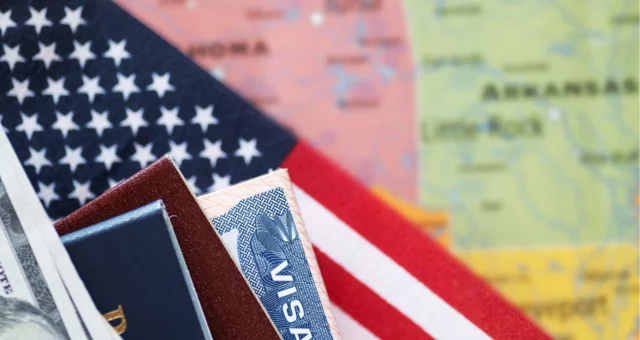New alien registration requirements take effect
Effective April 11, many non-citizens will be required to submit a registration application and be fingerprinted by the U.S. Department of Homeland Security.
These Alien Registration Requirements follow the issuance on March 12 of an Interim Final Rule by the DHS that was intended to implement Section 7 of President Trump’s Executive Order “Protecting the American People Against Invasion.” That section of the Executive Order directs the Secretary of Homeland Security to, among other things, ensure that unregistered non-citizens comply with registration and other requirements.
The registration application requirement will apply to all non-citizens age 14 or older who were not registered or fingerprinted when applying for U.S. visas or at the time of admission into the United States, if they have remained in the country for 30 days or longer. Non-citizens age 18 or older are also required to carry evidence of their registration at all times. Those who fail to comply with these requirements could face civil and criminal penalties.
Under §262 of the Immigration and Nationality Act, every non-citizen in the United States who is 14 or older and has not been registered or fingerprinted, and who remains in the country for 30 days or longer, must apply for registration and be fingerprinted. In addition, if the unregistered non-citizen is under age 14, the child’s parent or legal guardian must apply to register the child. Then, within 30 days of the date that the child turns 14, the child must apply in person for registration and be fingerprinted.
Who must register?
Non-citizens who meet any of the following criteria must register after remaining in the United States for 30 days:
- Individuals who entered the United States illegally.
- Canadian visitors who entered the United States at a land port of entry and who were not issued evidence of registration (such as Form I-94).
- Individuals who applied to USCIS for Deferred Action or Temporary Protected Status and were not issued evidence of registration.
- Individuals age 14 or older who were not registered or fingerprinted when applying for a U.S. visa, and who have remained in the United States for 30 days or longer.
- Parents or legal guardians acting on behalf of an individual who is under age 14 (registration only).
- Children who turn 14 while in the United States and have remained in the United States for 30 days or more (in-person registration and fingerprinting).
Who doesn’t have to register?
Non-citizens who entered the United States on a valid immigrant or nonimmigrant visa are already registered and do not need to register again. Non-citizens who have submitted certain applications with U.S. Citizenship and Immigration Services, and were fingerprinted, are also considered registered.
In addition, the following individuals are deemed registered and do not need to take further action:
- Lawful permanent residents.
- Individuals paroled into the United States under Section 212(d)(5) of the Immigration and Nationality Act, even if the period of parole has expired.
- Nonimmigrants issued Form I-94 (Arrival-Departure Record) or I-94W (paper or electronic), even if the period of admission has expired.
- Individuals present in the United States who were issued immigrant or nonimmigrant visas before their last date of arrival.
- Individuals in removal proceedings, including the following:
- I-221, Order to Show Cause and Notice of Hearing
- I-221S, Order to Show Cause, Notice of Hearing, and Warrant of Arrest of Alien
- I-862, Notice to Appear
- I-863, Notice of Referral to Immigration Judge
- Individuals who have been issued employment authorization documents.
- Individuals who have applied for lawful permanent residence and have filed forms and provided fingerprints, including the following:
- I-485, Application for Status as a Permanent Resident
- I-687, Application for Status as a Temporary Resident
- I-691, Notice of Approval for Status as a Temporary Resident
- I-698, Application to Adjust Status from Temporary to Permanent Resident
- I-700, Application for Status as a Temporary Resident
- Individuals with Border Crossing Cards (I-185, Nonresident Alien Mexican Border Crossing Card for citizens of Mexico)
How to register
This is a summary of the registration process:
- Create a USCIS online account.
- Go to “Forms Available to File Online,” scroll down to G-325R Biographic Information (Registration) and select “File Online.” Once the online form is completed and filed, the USCIS will then schedule the individual for an appointment, during which fingerprints and other biometric data will be collected.
- Once the biometrics are completed, the USCIS will issue a Registration Document (Form I-385) as evidence of registration.
Penalties
Non-citizens who are required to register and who willfully fail or refuse to do so may be charged with a misdemeanor, punishable by a civil fine of up to $5,000, imprisonment for up to six months, or both. Parents or guardians who fail to register a child within 30 days after the child turns 14 are subject to the same penalties.
Non-citizens age 18 or older who fail to carry proof of their registration at all times may also be charged with a misdemeanor and fined up to $5,000, or imprisoned for up to 30 days, or both.
Conclusion
It is important that all non-citizens comply with the Alien Registration Requirements, and carry proof of registration at all times if over the age of 18.
If you need assistance in complying with these requirements, please contact any member of Constangy’s Immigration Practice Group.






